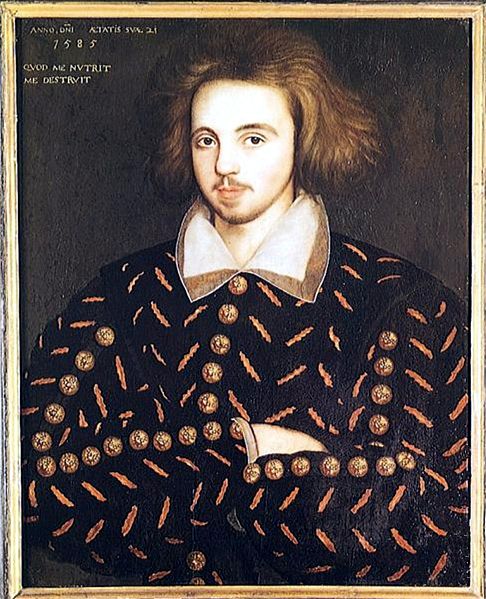Christopher Marlowe (baptised 26 February 1564 – 30 May 1593) was an English playwright, poet and translator of theElizabethan era. Marlowe was the foremost Elizabethan tragedian of his day. He greatly influenced William Shakespeare, who was born in the same year as Marlowe and who rose to become the pre-eminent Elizabethan playwright after Marlowe’s mysterious early death. Marlowe’s plays are known for the use of blank verse and their overreaching protagonists.
A warrant was issued for Marlowe’s arrest on 18 May 1593. No reason was given for it, though it was thought to be connected to allegations of blasphemy—a manuscript believed to have been written by Marlowe was said to contain “vile heretical conceipts.” On 20 May he was brought to the court to attend upon the Privy Council for questioning. There is no record of their having met that day, however, and he was commanded to attend upon them each day thereafter until “licensed to the contrary.” Ten days later, he was stabbed to death by Ingram Frizer. Whether the stabbing was connected to his arrest has never been resolved.
Literary career
Of the dramas attributed to Marlowe, Dido, Queen of Carthage is believed to have been his first. It was performed by the Children of the Chapel, a company of boy actors, between 1587 and 1593. The play was first published in 1594; the title page attributes the play to Marlowe and Thomas Nashe.
Marlowe’s first play performed on the regular stage in London, in 1587, was Tamburlaine the Great, about the conqueror Tamburlaine, who rises from shepherd to war-lord. It is among the first English plays in blank verse, and, with Thomas Kyd’s The Spanish Tragedy, generally is considered the beginning of the mature phase of the Elizabethan theatre. Tamburlaine was a success, and was followed with Tamburlaine the Great, Part II.
The two parts of Tamburlaine were published in 1590; all Marlowe’s other works were published posthumously. The sequence of the writing of his other four plays is unknown; all deal with controversial themes.
- The Jew of Malta (first published as The Famous Tragedy of the Rich Jew of Malta), about a Maltese Jew’s barbarous revenge against the city authorities, has a prologue delivered by a character representing Machiavelli. It was probably written in 1589 or 1590, and was first performed in 1592. It was a success, and remained popular for the next fifty years.
- Edward the Second is an English history play about the deposition of King Edward II by his barons and the Queen, who resent the undue influence the king’s favourites have in court and state affairs.
- The Massacre at Paris is a short and luridly written work, the only surviving text of which was probably a reconstruction from memory of the original performance text, portraying the events of the Saint Bartholomew’s Day Massacre in 1572, which English Protestants invoked as the blackest example of Catholic treachery. It features the silent “English Agent”, whom subsequent tradition has identified with Marlowe himself and his connections to the secret service. The Massacre at Paris is considered his most dangerous play, as agitators in London seized on its theme to advocate the murders of refugees from the low countries and, indeed, it warns Elizabeth I of this possibility in its last scene.
- Doctor Faustus (or The Tragicall History of the Life and Death of Doctor Faustus), based on the German Faustbuch, was the first dramatised version of the Faust legend of a scholar’s dealing with the devil. While versions of “The Devil’s Pact” can be traced back to the 4th century, Marlowe deviates significantly by having his hero unable to “burn his books” or repent to a merciful God in order to have his contract annulled at the end of the play. Marlowe’s protagonist is instead carried off by demons, and in the 1616 quarto his mangled corpse is found by several scholars. Doctor Faustus is a textual problem for scholars as two versions of the play exist: the 1604 quarto, also known as the A text, and the 1616 quarto or B text. Both were published after Marlowe’s death.
Additional information on Marlowe’s life, work, and influence can be found here.
